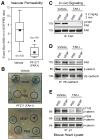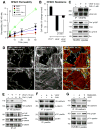VEGF-induced vascular permeability is mediated by FAK
- PMID: 22264731
- PMCID: PMC3266538
- DOI: 10.1016/j.devcel.2011.11.002
VEGF-induced vascular permeability is mediated by FAK
Abstract
Endothelial cells (ECs) form cell-cell adhesive junctional structures maintaining vascular integrity. This barrier is dynamically regulated by vascular endothelial growth factor (VEGF) receptor signaling. We created an inducible knockin mouse model to study the contribution of the integrin-associated focal adhesion tyrosine kinase (FAK) signaling on vascular function. Here we show that genetic or pharmacological FAK inhibition in ECs prevents VEGF-stimulated permeability downstream of VEGF receptor or Src tyrosine kinase activation in vivo. VEGF promotes tension-independent FAK activation, rapid FAK localization to cell-cell junctions, binding of the FAK FERM domain to the vascular endothelial cadherin (VE-cadherin) cytoplasmic tail, and direct FAK phosphorylation of β-catenin at tyrosine-142 (Y142) facilitating VE-cadherin-β-catenin dissociation and EC junctional breakdown. Kinase inhibited FAK is in a closed conformation that prevents VE-cadherin association and limits VEGF-stimulated β-catenin Y142 phosphorylation. Our studies establish a role for FAK as an essential signaling switch within ECs regulating adherens junction dynamics.
Copyright © 2012 Elsevier Inc. All rights reserved.
Figures







References
-
- Abedi H, Zachary I. Vascular endothelial growth factor stimulates tyrosine phosphorylation and recruitment to new focal adhesions of focal adhesion kinase and paxillin in endothelial cells. J Biol Chem. 1997;272:15442–15451. - PubMed
-
- Avraham HK, Lee TH, Koh Y, Kim TA, Jiang S, Sussman M, Samarel AM, Avraham S. Vascular endothelial growth factor regulates focal adhesion assembly in human brain microvascular endothelial cells through activation of the focal adhesion kinase and related adhesion focal tyrosine kinase. J Biol Chem. 2003;278:36661–36668. - PubMed
Publication types
MeSH terms
Substances
Grants and funding
LinkOut - more resources
Full Text Sources
Other Literature Sources
Molecular Biology Databases
Miscellaneous

